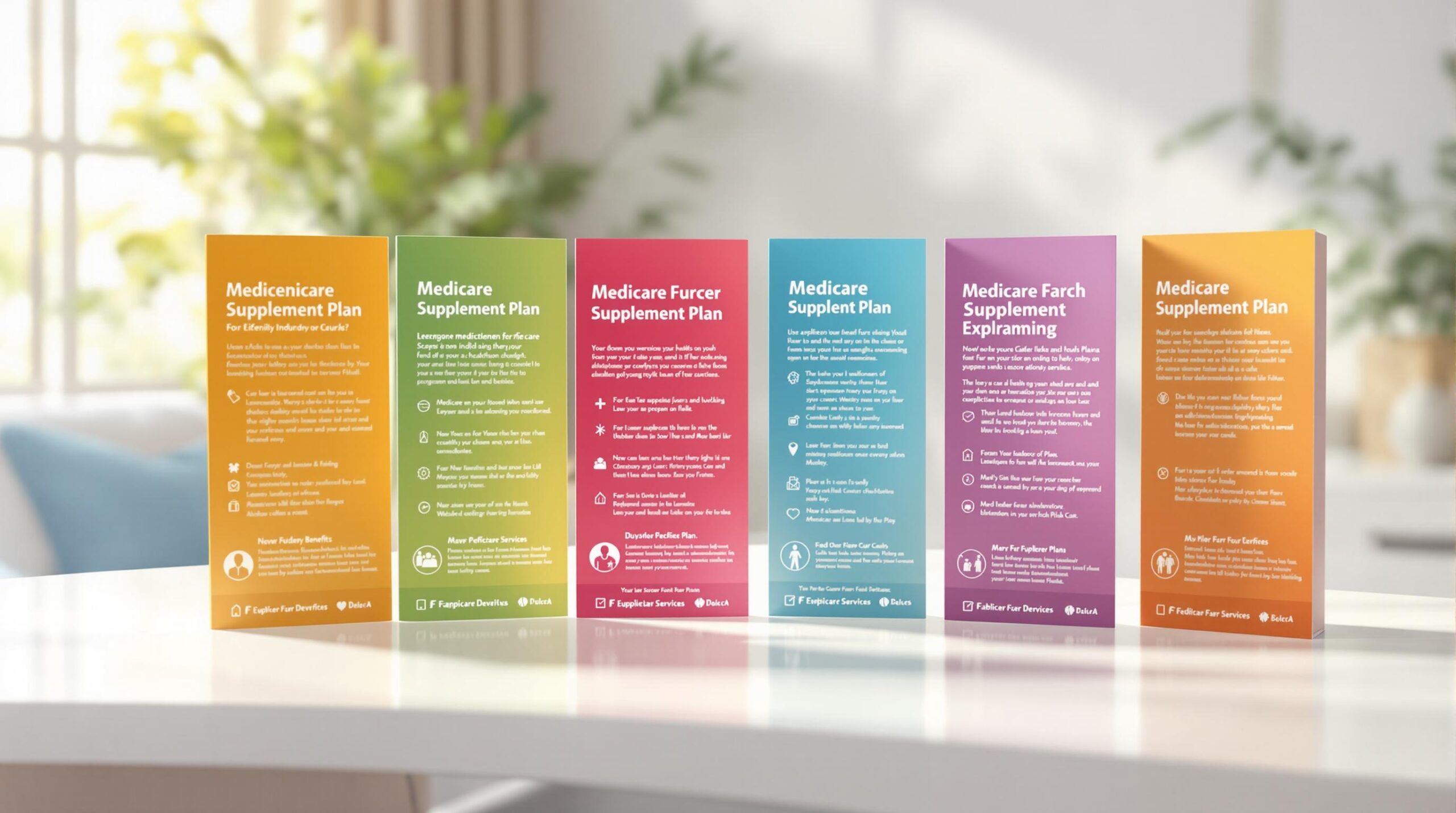Medicare Supplement (Medigap) plans help cover costs not fully paid by Original Medicare, like copayments, coinsurance, and deductibles. Here’s a quick breakdown of five popular plans:
- Plan F: Comprehensive coverage, but only available to those eligible before 2020. Higher premiums.
- Plan G: Similar to Plan F but excludes the Part B deductible. Popular for new enrollees due to lower premiums.
- Plan N: Lower premiums with small copayments for doctor and ER visits. No Part B excess charge coverage.
- Plan A: Basic coverage with low premiums but higher out-of-pocket costs. Does not cover Part A deductible or excess charges.
- Plan B: Adds Part A deductible coverage to Plan A but still lacks broader benefits like skilled nursing care or foreign travel emergencies.
Quick Comparison
| Plan | Avg. Monthly Premium | Part A Deductible | Part B Deductible | Excess Charges | Foreign Travel |
|---|---|---|---|---|---|
| Plan F | $186.49 | Yes | Yes | Yes | Yes |
| Plan G | $137.50 | Yes | No | Yes | Yes |
| Plan N | $111-$135 | Yes | No | No | Yes |
| Plan A | $85-$215 | No | No | No | No |
| Plan B | $141-$378 | Yes | No | No | No |
Choosing the Right Plan
- Frequent doctor visits? Plan G offers extensive coverage without high premiums.
- Minimal medical needs? Plan N saves money with lower premiums but includes small copays.
- Budget-conscious? Plan A provides basic coverage but leaves some costs uncovered.
Each plan has unique benefits and trade-offs. Compare premiums and coverage details to find the best fit for your needs.
Medicare Supplement Plans F, G, & N – Differences Explained
1. Plan F Coverage and Costs
Plan F is a Medigap plan that provides extensive coverage for those eligible for Medicare before January 1, 2020. It includes hospital costs under Part A, Medicare Part B deductibles, excess charges, skilled nursing facility coinsurance, and even foreign travel emergencies.
In Illinois, monthly premiums for Plan F vary significantly. For a 65-year-old female nonsmoker, they range from $171 to $267, with the 2023 average sitting at $186.49. There’s also a high-deductible version of Plan F, which comes with a $2,700 annual deductible (2023) and averages just $69.13 per month in premiums.
The main difference between Plan F and Plan G is that Plan F covers the Part B deductible, which Plan G does not. However, this added benefit comes with higher premiums. For those who want to minimize out-of-pocket costs, Plan F is often the go-to choice. On the other hand, some insurers, like Mutual of Omaha, offer more competitive rates for Plan G, making it increasingly popular among new Medicare enrollees.
Despite its higher premiums, Plan F remains a favorite for those who qualify, with 41% of Medigap enrollees choosing it for its extensive coverage. However, Plan G is gaining traction as a cost-effective alternative for new enrollees looking for broad benefits at a lower price.
2. Plan G Coverage and Costs
For individuals who became eligible for Medicare after January 1, 2020, Plan G serves as the closest alternative to Plan F. It provides extensive coverage, taking care of nearly all out-of-pocket expenses tied to Original Medicare, except for the Medicare Part B deductible.
Plan G premiums average around $138 per month for a 65-year-old female nonsmoker in Illinois. For those looking to save on premiums, there’s also a high-deductible version with a $2,800 deductible for 2024. However, with this option, you’ll need to cover all costs until the deductible is met .
In Illinois, major insurers like Mutual of Omaha and AARP/UHC offer competitive rates starting at $122 per month. Plan G also includes coverage for foreign travel emergencies (subject to plan limits) with a $250 deductible, and it fully covers Part B excess charges .
This plan is a popular choice for those seeking reliable coverage at a predictable cost. It allows access to any provider that participates in Medicare, helping beneficiaries manage healthcare expenses throughout the year.
While Plan G is known for its balance of coverage and cost, Plan N provides another option for handling out-of-pocket expenses.
3. Plan N Coverage and Costs
Plan N offers a budget-friendly Medigap option, with an average premium of $112 for a 65-year-old female nonsmoker in Illinois. It provides a balance between cost and coverage, making it a popular choice for many residents.
This plan covers most out-of-pocket costs under Medicare Part A and Part B, but there are a few exceptions. Beneficiaries are responsible for:
- $20 copay for doctor visits
- $50 copay for emergency room visits (if not admitted as an inpatient)
- The Medicare Part B deductible
- Any Part B excess charges
Monthly premiums in Illinois typically range from $120 to $127, depending on the provider. Since prices vary, shopping around and comparing insurers is essential.
For example, a 65-year-old female nonsmoker could save $170 annually with Plan N compared to Plan F. However, these savings come with trade-offs, such as paying small copays for medical services.
Plan N does not include international emergency coverage but still provides key benefits like hospital coinsurance, hospice care, and skilled nursing facility coverage.
This plan is ideal for those who prefer lower premiums and don’t mind occasional copayments. It’s particularly appealing for individuals in good health who don’t require frequent doctor visits. For those looking for even lower premiums and more basic coverage, Plan A might be worth considering.
sbb-itb-a729c26
4. Plan A Coverage and Costs
Plan A is the most basic Medigap plan available in Illinois. It provides essential coverage at a lower monthly premium compared to more extensive plans. In 2023, the average monthly premium for Plan A is $234.98, though this can vary widely depending on your location and provider.
Here’s what Plan A covers:
- Medicare Part A coinsurance and hospital costs
- Medicare Part B coinsurance/copayment
- The first 3 pints of blood
- Hospice care coinsurance
Premiums for Plan A in Illinois range from $103 to $1,371, depending on factors like your age and where you live. Because of this wide range, it’s a good idea to compare different insurers. Keep in mind that while Plan A has lower premiums, it also comes with higher out-of-pocket costs. It does not cover the Medicare Part A deductible, Part B deductible, foreign travel emergencies, or Part B excess charges .
Plan A is a good fit for individuals who:
- Want the lowest possible monthly premiums
- Are comfortable covering some out-of-pocket expenses
- Anticipate minimal medical needs
- Don’t travel internationally often
While the premiums are more affordable, you’ll need to budget for deductibles and other uncovered expenses. For example, you’ll have to pay the Medicare Part A deductible yourself, which could significantly affect your annual healthcare costs. This makes Plan A a practical option for those new to Medicare who want basic, low-cost coverage.
If you’re looking for slightly more coverage than Plan A provides, Plan B might be worth considering, as it includes additional benefits.
5. Plan B Coverage and Costs
Plan B offers a middle ground for those looking for more benefits than Plan A without the higher monthly premiums of Plans F or G. Premiums typically range from $141 to $378 per month, depending on your location and provider.
This plan covers Medicare Part A coinsurance, hospital costs, and the Part A deductible. However, it does not include the Part B deductible, skilled nursing facility care, foreign travel emergencies, or Part B excess charges. Essentially, it provides better hospital-related coverage than Plan A but doesn’t go as far as Plans F or G.
Plan B works well for individuals who:
- Need more hospital coverage than Plan A but find Plans F or G too expensive
- Are focused on hospital-related expenses
- Don’t require benefits for skilled nursing care
- Rarely travel outside the country
In Illinois, the cost of Plan B can vary depending on where you live within the state. During the Medigap Open Enrollment Period, Plan B is guaranteed issue, meaning you can enroll without health assessments. Outside this window, insurers may review your health to determine premiums or eligibility.
Knowing the specifics of Plan B’s coverage and costs can help you decide how it stacks up against other Medigap plans, which we’ll dive into next.
Plan Comparison Chart
Here’s a breakdown of how five Medicare Supplement Plans compare, based on 2024 data for Illinois residents. This chart highlights key features and costs to help you decide which plan fits your needs.
| Feature | Plan F | Plan G | Plan N | Plan A | Plan B |
|---|---|---|---|---|---|
| Average Monthly Premium | $186.49 | $137.50 | $111-$135 | $85-$215 | $141-$378 |
| Part A Deductible Coverage | Yes | Yes | Yes | No | Yes |
| Part B Deductible Coverage | Yes | No | No | No | No |
| Part B Excess Charges | Yes | Yes | No | No | No |
| Foreign Travel Emergency | Yes | Yes | Yes | No | No |
| Skilled Nursing Facility | Yes | Yes | Yes | No | No |
| Copayments Required | No | No | Yes* | No | No |
| Availability to New Enrollees | No** | Yes | Yes | Yes | Yes |
*Plan N includes copayments of up to $20 for office visits and up to $50 for ER visits.
**Plan F is limited to those eligible for Medicare before January 1, 2020.
For instance, in Chicago, IL, 2024 premiums vary significantly:
- Plan F: $137 to $1,065
- Plan G: $106 to $830
- High-Deductible Plan G: $40 to $245
Plan G is becoming a top choice for new enrollees because it offers nearly the same coverage as Plan F but at a lower cost. While Plan F still holds 41% of Medicare Supplement beneficiaries, there’s a noticeable shift toward Plan G due to its affordability and coverage balance.
Keep in mind, actual costs depend on factors like your location, age, and provider. This comparison serves as a starting point to help you identify a plan that matches your healthcare needs and budget.
Next, let’s dive into how to select the plan that’s right for you.
How to Choose Your Plan
When selecting a healthcare plan, take a close look at your medical needs and overall costs, including premiums, deductibles, and copayments. For those with frequent doctor visits or ongoing treatments, Plan G might be a better fit due to its broader coverage. On the other hand, Plan N could save money with lower premiums if your medical needs are minimal.
Key Cost Factors
Use the Plan Comparison Chart above to quickly review premium ranges and coverage details. Here’s a breakdown of what to consider:
| Cost Component | What to Consider |
|---|---|
| Monthly Premium | Includes base rate plus adjustments for age/location |
| Annual Deductibles | Part B deductible is $240 in 2024 |
| Copayments | Depends on the chosen plan |
| Out-of-pocket Maximum | Varies by plan and carrier |
Regional Pricing Differences
In Illinois, prices can vary widely depending on the region. To get accurate pricing and options, it’s a good idea to consult local agents.
Planning for Current and Future Needs
If you’re new to Medicare, Plan G is often a solid choice, offering extensive coverage at competitive rates. Make sure to think about both your current healthcare needs and any potential future requirements.
Network and Provider Checks
Ensure that your preferred healthcare providers accept Medicare assignment before finalizing your plan choice.
Special Considerations for Travelers
If you travel frequently, Plans F, G, and N include foreign travel emergency coverage. However, Plans A and B don’t offer this benefit, so keep that in mind.
Best Time to Enroll
The ideal time to enroll is during your Medigap Open Enrollment Period, which begins when you turn 65 and sign up for Medicare Part B. During this window, you’re guaranteed coverage without being charged extra due to pre-existing health conditions.
Your personal situation should drive your decision. Speaking with a licensed insurance agent can help you get tailored advice based on your needs.
Next, we’ll dive into common questions about Medicare Supplement plans to help you make an informed choice.
FAQs
Who offers the best Medigap plan?
In 2024, several providers stand out for their coverage, pricing, and customer satisfaction:
- AARP/UnitedHealthcare: Known for its strong Plan G options and competitive pricing.
- Anthem: Offers some of the lowest rates for Plan G, with an average cost of $137.50 per month in 2023.
- Blue Cross Blue Shield: Features a broad provider network and a variety of plans, including Plan F for those eligible before 2020.
- State Farm: Highly rated for financial stability and customer satisfaction.
- Humana: A great choice for High-Deductible Plan G, with average monthly premiums of $69.13.
"Choose a provider that matches your needs. While AARP/UnitedHealthcare offers excellent overall value, Anthem might be more suitable for budget-conscious consumers seeking basic coverage."
To get the most accurate and up-to-date pricing tailored to your location in Illinois, consider working with a licensed insurance agent. Providers differ in pricing, customer service, and additional perks, so it’s important to evaluate what matters most to you.
Knowing which providers excel is just the first step. Next, focus on how to choose the plan that aligns with your specific needs.




0 Comments